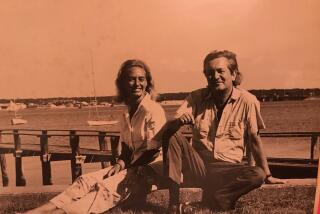Best in the West : Eulogy: Friends, students and admirers remember Wallace Stegner as a chronicler who brought realism and dignity to regional writing.
There’s this image of the Wild West as the home of rugged individualists, lonely grizzled souls who got no need for no one or no dang thing.
*
Wallace Stegner’s death Tuesday night, though, gives that myth perspective.
Across the United States, phones rang with word that the writer, teacher and historian had died in Santa Fe, from complications suffered in a March 28 traffic accident.
Stegner, 84, has been widely eulogized since, praised for his more than two dozen books that included the Pulitzer Prize-winning novel “Angle of Repose,” and “The Spectator Bird,” which won a National Book Award in 1977.
Many also noted that he founded the creative writing program at Stanford University, and that a number of his students went on to achieve more literary celebrity than their mentor--Ken Kesey, Larry McMurtry, Tillie Olsen and Robert Stone.
But it isn’t just the unusually tight-knit community of students who took notice of “Wally’s” passing. A loosely knit network of friends, professional acquaintances, mere professional admirers--some now doing the most to interpret, redefine and protect the West--pondered the loss.
Ivan Doig, author of numerous books about the Pacific Northwest including “This House of Sky: Landscapes of a Western Mind,” says “there’s a broader rainbow of work from Stegner almost than was imaginable. He wrote short stories, novels essays, history, biography, and a magical book we can’t even classify--’Wolf Willow.’
“There’s an entire body of literature from this one homestead kid. That seems to me one of the literary miracles of all American history.”
Others were equally effusive:
* Novelist Robert Stone, one of Stegner’s more celebrated Stanford students, says that his mentor’s influence as a writer and teacher extended well beyond his academic sphere.
Stegner’s writing “reflected the changing of the West, the changing of California from the ‘50s, when he was first out on the West Coast, to the ‘90s. He was a really good recorder of all that. No one did that better. . . . He was not an eccentric stylist at all, but his writing was tremendously sound and clear and good.
“His work was very like him. It shows a real sense of decency. He really was a kind of mentor and parent to a whole lot of us.”
* Novelist and teacher William Kittredge says that “once I got it in my head that I wanted to write, Stegner was one of few models I had.” Kittredge, whose “The Last Best Place” anthologizes the vast writing wealth that has come out of Montana, says Stegner “gave us all heart. His work showed reverence for the kind of place we grew up.”
Before Stegner, he adds, writing about the West, painting about the West and Western movies “all told the same kind of cowboy and Indian shootout story, the story of white men conquering the West, taking it over and making it their own possession. That was a mythological view, and to many of us who grew up here, sort of nonsensical.
“Stegner showed us that there were other stories to tell. We all knew that. But he made it valid to make art out of life in rural Montana.”
* Author Annie Dillard calls Stegner a wonderful writer. Dillard, whose “Pilgrim at Tinker Creek” won a Pulitzer Prize and whose novel “The Living” was a best seller last year, says Stegner “saw what could be done with Western history. He took 19th-Century West Coast history seriously. That meant a lot to me.”
She was particularly impressed with Stegner’s novel “Angle of Repose.”
“He had very few characters, very little incident, and what he did was go over it, making it deeper and deeper and deeper, dealing with the woman (his main character) again and again and again until she had a mythological stature. She became figural.”
* Annick Smith, a writer and filmmaker, says Stegner’s reshaping of the Western myth helped make possible the telling of “an honest story about women in the West” in the film “Heartland,” for which she served as executive producer.
Smith, who co-produced the film “A River Runs Through It” and co-edited the anthology “The Last Best Place,” says that Stegner “showed that it was possible not just to tell stories about “sturdy pioneer women and prostitutes with hearts of gold, but stories about women with specific lives and specific goals who did things that changed the country.”
* James Welch, a Blackfeet Indian and author of “Fools Crow” and “Indian Lawyer,” appreciates Stegner’s portrayal of the West’s original inhabitants: “He created a new image of the contemporary West, complete with its problems, that was different from the romantic, Westward expansion version of Indians.
“He got people involved in stories about this new West. His writing was very conscious of its social issues. But he combined everything to tell terrific stories. When you’re a great writer, like Wallace was, the story transcends the message in a sense.”
* Barry Lopez says Stegner “wrote me letters about my work that made my hair stand on end.” Lopez, author of the award-winning “Arctic Dreams,” and “Crow and Weasel,” a children’s book that Robert Redford has developed for the stage, says Stegner “was the only man whose compliments made me feel I had to do more. A compliment from him meant more than just a slap on the back. It meant: ‘Good work and you’d better keep working. . . . ‘
“For writers like me who never took a class with him, he taught us how to behave. He encouraged us to think hard about our responsibilities--not just to language, or, God forbid, to the literary community. But to the larger community.”
Stegner’s commitment to public citizenship, Lopez believes, may prove the most important part of his multifaceted legacy: “He had an effect we cannot possibly know on land policy. He was sought out by presidents, governors, and secretaries of the interior for probably 40 years.”
* Secretary of the Interior Bruce Babbitt was acquainted with Stegner and remains an ardent admirer. He says that he’d hoped to meet with Stegner this spring to discuss Babbitt’s plan for a new U.S. Biological Survey (based on the Geological Survey).
“Stegner’s ‘Beyond the 100th Meridian’ touched my life most deeply,” Babbitt recalls. “I read it in college and it opened me up to a whole new view of the West. I grew up in the West of rugged individualism that was steeped in a sort of distrust of the federal government.
“What he taught me with that book was to understand the love-hate relationship between Westerners and the federal government. . . . We in the West would never have made it without this relationship. We would have ruined everything. Now that I’m on the other side, I see the historical tension in that love-hate relationship. That’s very important.”
* Poet, novelist, essayist and Kentucky farmer Wendell Berry studied in Stegner’s Stanford program in 1958.
“When I first met Wally, I assumed that I would probably spend my life in some city, probably at a university, far away from my native place,” Berry remembers. “But as it happened, I later decided to return to my own part of the world to live. I became a consciously regional writer, a writer who would write about one place.
“At that point he became more to me than simply teacher and writer, but an example, because he is really the best example I know of a writer devoted to his region.”
* Essayist Gretel Ehrlich, author of the critically acclaimed “Solace of Empty Places,” arrived home Wednesday evening and found five phone messages about Stegner’s death from far-flung points.
“That’s one of the unusual things about writers who work out of the West--and it has a lot to do with Stegner--there’s a kind of bond we have,” she says. “He’s given us a sense that we belong to this unique and difficult place, and that our common residence here gives us a way of connecting to each other that a lot of writers lack.
More to Read
Sign up for our Book Club newsletter
Get the latest news, events and more from the Los Angeles Times Book Club, and help us get L.A. reading and talking.
You may occasionally receive promotional content from the Los Angeles Times.






